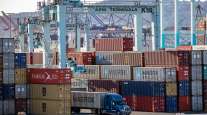Staff Reporter
California’s Container Ports to Develop Shared Data System

[Stay on top of transportation news: Get TTNews in your inbox.]
California’s five container ports have agreed to develop a $27 million, high-tech supply chain infrastructure using a computer cloud to share data and cargo flow information to reduce delays and improve resiliency.
All five container ports (the Port of Hueneme, the Port of Long Beach, the Port of Los Angeles, the Port of Oakland and the Port of San Diego) recently entered into a memorandum of understanding in Sacramento called the California Port Data Partnership.
Although the state’s ports handle 40% of all U.S. containerized imports and 30% of the nation’s containerized exports, the Port of Oakland alone discharges 99% of containerized goods moving through Northern California.
They plan to have an interoperable cloud-based computer system to share information that will result in a better freight system with more efficiency, lower emissions and enhanced economic competitiveness. Information is to be securely shared in cloud-based data systems by port users and relevant transportation providers.
Today, our five containerized ports signed a historic MOU launching the CA Port Data Partnership alongside state & federal partners.
This MOU & the funding that follows will increase cooperation & standardization tied to the state's supply chain data. https://t.co/H6cllZAGj0 pic.twitter.com/rf2E1LsokN — GO-Biz (@CAGoBiz) April 26, 2023
“The MOU is a first-of-its-kind agreement on data system development among containerized ports and outlines 11 areas of cooperation, ranging from developing data definitions to ensuring equitable access to data for users,” said Dee Dee Myers, GO-Biz director and senior adviser to the governor. “This MOU and the funds that follow will build the basis for greater cooperation and standardization when it comes to data in our supply chain.”
The project’s $27 million came from GO-Biz grant funds for port data system development and were in the state’s Budget Act of 2022, which included investments in California’s freight movements and supply chain.

Kounalakis
Mario Cordero, Port of Long Beach executive director, commented, “Sharing vital shipping data will reduce delays and aid the entire goods movement industry from the docks to doorsteps. By working together, California’s ports can enable end-to-end visibility and connectivity across the supply chain.”
During the past several months, officials from the ports and states held biweekly roundtables to develop the agreement’s framework.
“California’s ports are an essential link in the global supply chain,” noted Eleni Kounalakis, California lieutenant governor.
Kristin Decas, Port of Hueneme CEO and director, said this new strategic technological alignment and partnership will help “minimize disruptions and prosper fluidity in goods movement.”
According to the MOU, the container ports acknowledged that developing the data system should involve collaborating with California industries across the supply chain, such as logistics and warehousing, transportation, agriculture, retail, manufacturing, energy, building and construction, aerospace and defense, technology, entertainment, tourism, biotechnology, utilities and natural resource management.
Want more news? Listen to today's daily briefing above or go here for more info
It calls for the ports to work with “other local, state and federal entities of government, private industry partners and other interested parties to support interoperability and port data system development.”
Rafael Castellanos, chairman of the Port of San Diego’s Board of Port Commissioners, said he appreciates the opportunity to collaborate with the state’s other container ports to improve operations, increase throughput and enhance customer service through the Ports Data Partnership.
“We are an indispensable economic engine pumping $9.2 billion into our country’s economy and we serve as an integral part of our national security,” Castellanos said. “This is particularly important as our port, through our Maritime Clean Air Strategy, is creating a greener, cleaner and more modern seaport.”




